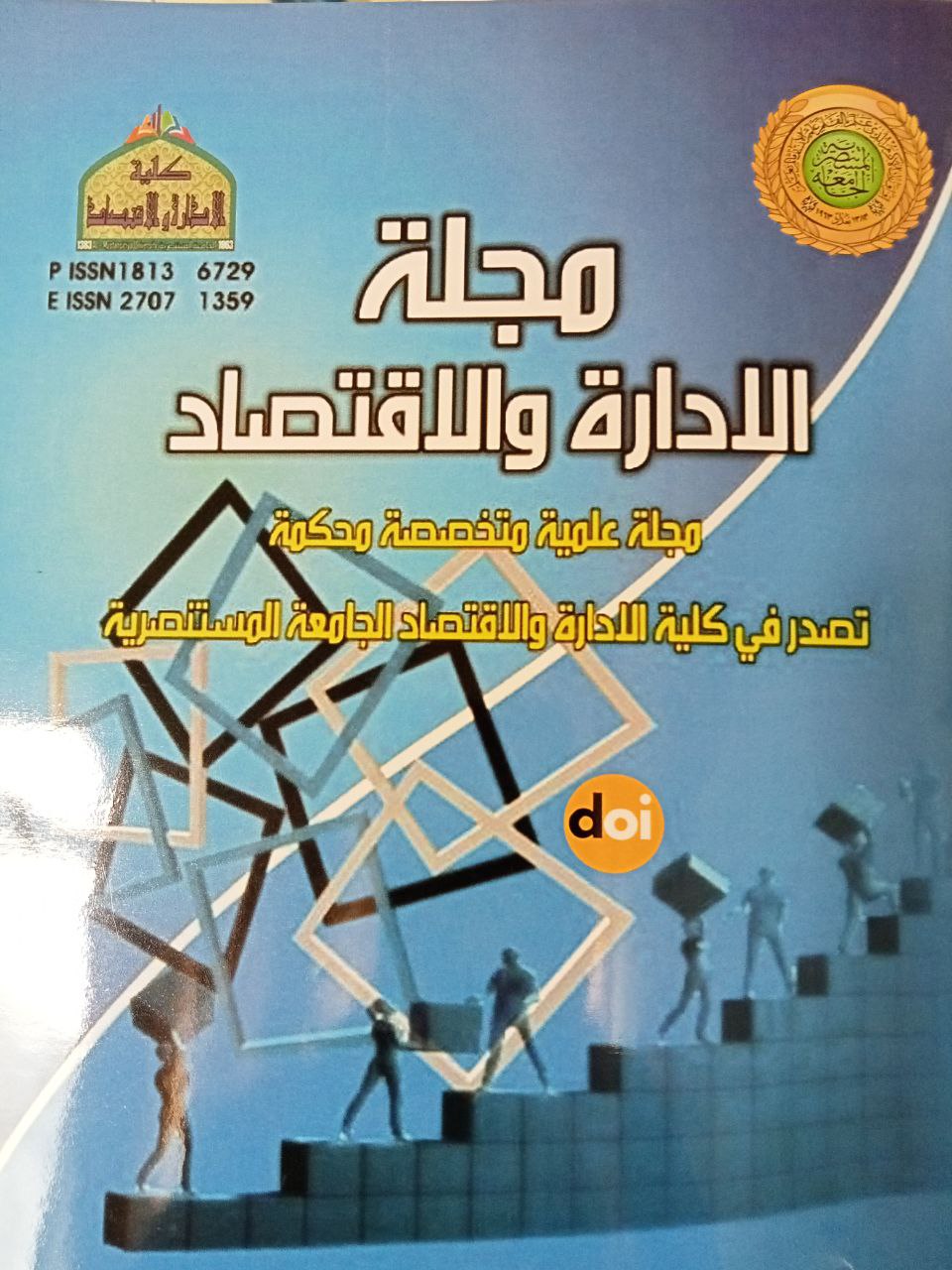Using the Box-Jenkins methodology to predict the number of participants for the Continuing Education Center at the Middle Technical University
DOI:
https://doi.org/10.31272/jae.i134.1213Keywords:
Time series, Jenkins box, stability, unit rootAbstract
The time series analysis method is one of the important statistical methods in studying a phenomenon over a certain period. Through this analysis, the pattern of the series is identified and used to predict the future values of the phenomenon, which helps in making the appropriate decision and developing sound plans for the future. The research aims to choose the best model to predict the number of participants for the Continuing Education Center at the Central Technical University, using Jenkins Box models, and to choose the best model by comparing models by using differentiation criteria, as the models developed by the two scientists were relied upon, (Jenkins & Box Jenkins) and it is during the development of a methodology in the study and analysis of autoregressive models - moving media for time series starting from the process of checking the stability through the autocorrelation and partial autocorrelation integrated ARIMA, the instability of the series appeared and stabilized after taking the first difference, and to ensure the significance of the stability, the ADF test was relied on. Determining the best model based on the used accuracy criterion (AIC). The greatest possibility function was used in estimating the model parameters, where the ARIMA model (1,1, 0) was chosen as the best model from the Box Jenkins models, and the significance of the chosen model was tested for the studied phenomenon to ensure the suitability of the model from During the confidence interval test for the residuals, which indicates that the error series of the model is random, as well as the plot of the original series And the estimated series of the estimated model ARIMA(1,1,0), a semi-match was observed between the curves of the original series and the estimated, and this gives us an idea of the importance and accuracy of the estimated model (ARIMA(1,1,0). One of the most important conclusions is that the original series was unstable When the Dickey-Fuller test was conducted, it became stable when the first difference was taken, and one of the most important recommendations is to take advantage of the results of the research to develop appropriate plans and policies in developing the work of the Continuing Education Center, preparing the training rooms and equipping them with modern technologies, developing and diversifying training curricula and improving other services in the center. In the center in terms of training and engaging them in training and development courses in the field of (computer and administrative development) to improve their performance to meet the changes in the number of participants. The statistical program Eviews was used.
Downloads
References
المصادر العربية
- فلحي ، فاطمة هاشم " تحليل السلاسل الزمنية للتنبؤ باعداد التلاميذ في الصف الاول الابتدائي باستعمال منهجية بوكس جينكينز ((دراسة تطبيقية في محافظة البصرة ))"، 2020، مجلة العلوم الاقتصادية. .... المجلد(15) العدد ( 59).
- البيرماني،فاطمة عبد الحميد ، ارشيد، احمد جودة، "استعمال السلاسل الزمنية للتنبؤ بالارقام القياسية لإيجارات الدور السكنية في العراق للسنوات 2018- 2021 "، 2019 ، مجلة كلية الرافدين الجامعة للعلوم، العدد45.
المصادر الأجنبية
-FULLER A.W. "Introduction to Statistical Time Series". (1996) JOHN WILEY & SONS، INC،
New York.
-Dickey D. and Fuller W. " The likelihood Ratio Statistics for Autoregressive Time Series
With a unit Root"، 1981 Econometrical ،n49: p.p .1057-1072.
-Dickey D. and Fuller W. " Distribution of the estimators for Autoregressive Time Series With
a unit Root "، Journal of the American Statistical Association، 1979 n74: p.p .427-431
رسائل ماجستير
- الطائي ،عدوية حسن يوسف،"استعمال بعض نماذج السلاسل الزمنية للتنبؤ بمحصول الرز في بعض مناطق الوسط والجنوب في العراق" ،2016 ،جامعة بغداد كلية الإدارة والاقتصاد.
- صغير ،عور احوذ، " إستخذام منهجية بوكس جينكينز للتنبؤ بمعدلات التضخنم في السودان – دراسة قياسية في الفترة (1978م- 2011 م) "،2015 ،جامعة السودان للعلوم والتكنلوجيا .
- حضري، خولة ،"استعمال السلاسل الزمنية من خلال منهجية بوكس جينكينز في اتخاذ القرار الإنتاجي دراسة حالة مطاحن رياض سطيف-وحدة تقرت- في الفترة ( 2008 - 2013)"، 2015 ،جامعة محمد خيضر – بسكرة – كلية العلوم الاقتصادية و التجارية و علوم التسيير- قسم علوم التسيير.
- الديراوي ،عبد الله سلمان محمد " استخدام نموذج الجار الأقرب وطريقة بوكس -جينكنز في التنبؤ بالسلاسل الزمنية" ،2015،جامعة الازهر غزة – كلية الاقتصاد والعلوم الإدارية .
- بوزیدي حافظ أمین " استخدام منهجية بوكس جينكيتر للتنبؤ بحجم الطلب على منتوجات الصناعات الغذائية في الجزائر (السميد نموذجا)"، 2014 ، جامعة محمد خيضر – بسكرة، كلية العلوم الاقتصادية و التجارية و علوم التسيير قسم علوم التسيير.
- الطيب ، رقية عبد الله، "تحليل السلاسل الزمنية واستعماله لبناء نماذج حوادث المرور في ولاية الخرطوم 2006 م- 2013 م " ، 2014 ،جامعة السودان للعلوم والتكنولوجيا – كلية الدراسات العليا .
- أبو راضي ، سمرين سمير خليل ،" تحليل حجم تداول اسهم البنوك المدرجه في بورصة عمان باستعمال نموذج السلاسل الزمنية – دراسة حالة " 2009،جامعة الشرق الأوسط للدراسات العليا _كلية الاعمال.
الكتب
- شعراوي ، سمير مصطفى ، "مقدمة في تحليل الحديث للسلاسل الزمنية" ، كلية العلوم ، جامعة الملك بن عبد العزيز ، المملكة العربية السعودية،الطبعة الأولى 1426 ه (2005 م) .
- بري، د.عدنان ماجد ، "طرق التنبؤ الإحصائي" ، كتاب، جامعة الملك سعود ،2002 .
-الصراف وشومان، د.نزار مصطفى، د.عبد اللطيف حسن ، "السلاسل الزمنية والأرقام القياسية"، دار الدكتور. للعلوم الإدارية والاقتصادية، بغداد، 2013.

Downloads
Published
Issue
Section
License
The journal of Administration & Economics is an open- access journal that all contents are free of charge. Articles of this journal are licensed under the terms of the Creative Commons Attribution International Public License CC-BY 4.0 (https://creativecommons.org/licenses/by/4.0/legalcode) that licensees are unrestrictly allowedto search, download, share, distribute, print, or link to the full text of the articles, crawl them for indexing and reproduce any medium of the articles provided that they give the author(s) proper credits (citation). The journal allows the author(s) to retain the copyright of their published article.
Creative Commons-Attribution (BY)









